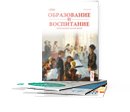This article examines the influence of various online resources—such as courses, video lessons, mobile apps, and social networks—on student motivation in learning English. It highlights their effects on intrinsic and extrinsic motivation, flexible learning schedules, and diverse formats. Additionally, the article discusses the benefits and challenges of online resources, including increased engagement, interactivity, personalized learning, and potential technology dependence. The importance of integrating online tools with traditional methods for optimal outcomes is also emphasized.
Keywords: online resources, student motivation, English language learning, online courses, video lessons, mobile apps, social networks, engagement, interactivity, personalized learning, flexibility, educational technology.
In today's digital age, learning English has become essential for communication, career opportunities, and personal growth. Technological advancements have introduced diverse online resources, significantly transforming English language learning. These resources, ranging from interactive platforms to educational videos and mobile apps, provide students with flexibility, engagement, and personalized learning experiences. The main goal of this article is to explore how online resources influence students' motivation to learn English, examining both the positive and negative aspects of their impact. Through this exploration, we aim to understand how these resources can be effectively used to support and boost students' language learning journey.
The availability of online resources has revolutionized language learning, providing students with a wide range of tools to enhance their English skills. These resources can be categorized into several types, each offering unique features that cater to different learning styles and preferences.
One of the most popular and comprehensive resources for learning English is online courses. Platforms like Duolingo, Coursera, and Khan Academy offer structured lessons that range from beginner to advanced levels. Duolingo, for example, gamifies language learning, turning the process into a fun and interactive experience that encourages students to keep progressing. Coursera and Khan Academy, on the other hand, offer more in-depth lessons often created by university professors, allowing students to gain a deeper understanding of grammar, vocabulary, and pronunciation. [1] These platforms often include quizzes and assignments that not only help reinforce learning but also motivate students to track their progress and set goals.
Another powerful type of online resource is video-based learning. Websites like YouTube and TED Talks provide students with visual and auditory content that aids comprehension and engagement. YouTube hosts a variety of channels dedicated to English language learning, such as BBC Learning English and English with Lucy, which present lessons on everything from pronunciation tips to grammar explanations. [2] TED Talks, with their captivating and informative speeches on various topics, give students the opportunity to hear English spoken by native speakers in real-world contexts. This helps learners improve their listening skills and exposes them to diverse accents and vocabulary.
Mobile applications are another essential resource for language learners. Apps such as Memrise, HelloTalk, and Babbel provide convenient, on-the-go learning options that can be accessed from smartphones or tablets. These apps often feature interactive exercises, vocabulary games, and even opportunities for language exchange with native speakers. Their portability allows learners to practice English in their spare time, making it easy to integrate language learning into daily life. The instant feedback and personalized learning paths these apps offer help maintain students’ motivation by showing immediate results and progress. [3]
In addition to formal learning platforms, online forums and social media groups also play a significant role in student motivation. Websites like Reddit and Facebook host communities where learners can connect, share experiences, and seek advice from others. On Reddit, for example, learners can join subreddits dedicated to English language learning, where they can ask questions, share resources, and engage in discussions. Facebook groups offer similar opportunities for peer interaction, allowing students to form study groups or practice their skills in a social, informal environment. These platforms encourage learners to feel part of a supportive community, which can be highly motivating and help overcome feelings of isolation that sometimes accompany online learning.
The variety of online resources not only provides flexibility in how and where students learn but also plays a crucial role in sustaining their motivation. These tools impact both intrinsic and extrinsic motivation, encouraging active engagement with learning materials in diverse ways.
Firstly, online platforms boost intrinsic motivation by fostering a sense of personal achievement. Resources like Duolingo or TED Talks allow students to track progress, celebrate small victories, and witness their growth, reinforcing their desire to learn for personal fulfillment. At the same time, gamification elements—such as earning points or badges—act as extrinsic motivators, blending self-improvement with tangible rewards.
Another key factor is flexibility. The ability to study at one's own pace and convenience makes learning more accessible, particularly for those juggling work, family, or other commitments. Mobile apps and online courses enable students to learn without the constraints of rigid schedules, enhancing their sense of autonomy. The option to revisit lessons or replay videos further supports individualized learning, ensuring better retention.
Additionally, the diversity of formats keeps learners engaged by catering to different preferences. Some students benefit from video lessons that visualize concepts, while others prefer text-based materials. Interactive exercises and quizzes provide immediate feedback, reinforcing knowledge and preventing the monotony often associated with traditional learning methods. [4]
Beyond motivation, online resources significantly enhance student engagement. Traditional classrooms can sometimes feel passive, whereas digital platforms encourage active participation. Apps like Duolingo incorporate bite-sized, interactive lessons that require students to make choices, speak aloud, and apply their knowledge, preventing disengagement.
Personalization is another advantage. Many platforms, such as Babbel and Memrise, adapt lesson difficulty based on student performance, ensuring efficient and targeted learning. Features like instant feedback, progress tracking, and customizable learning paths help students focus on areas for improvement while maintaining control over their learning journey.
Finally, the integration of gamified elements—such as challenges, quests, and reward systems—transforms language learning into an enjoyable experience. By turning lessons into interactive games, apps provide students with clear goals, fostering a sense of accomplishment and sustained enthusiasm. [5]
By combining flexibility, interactivity, personalization, and engaging formats, online resources not only enhance motivation but also make language learning more effective and enjoyable. These benefits establish digital tools as invaluable assets for students striving to improve their English skills while maintaining long-term commitment and interest.
Although online resources offer numerous benefits for student motivation and engagement, they also present certain challenges that can impact the learning process.
One major drawback is the lack of direct interaction with a teacher. While online platforms provide extensive materials and instant feedback, they cannot fully replicate the dynamic, personalized guidance of a classroom. In traditional settings, instructors can assess students’ understanding in real-time, adapt explanations, and offer immediate support—something digital resources may struggle to provide effectively. This absence of face-to-face communication can make it harder for students to ask questions, seek clarification, or receive tailored instruction.
Another challenge is the risk of over-reliance on technology, which can lead to issues with self-discipline. The flexibility of online learning, while advantageous, can also encourage procrastination and inconsistency, especially without structured schedules or external supervision. [6] Additionally, easy access to digital distractions may reduce students' intrinsic motivation, making them more dependent on the convenience of online tools rather than actively engaging in the learning process. Technical issues, such as poor internet connectivity or software malfunctions, can further disrupt progress and create frustration.
Despite these limitations, online resources remain a valuable tool for language learning. To maximize their effectiveness, it is important to balance digital learning with other forms of educational interaction, ensuring a well-rounded and structured approach.
In conclusion, online resources have proven to be a powerful tool in enhancing student motivation in English language learning. Their flexibility, variety of formats, and interactive elements not only make learning more engaging but also provide students with the freedom to study at their own pace, which significantly boosts both intrinsic and extrinsic motivation. The personalized learning paths, availability of diverse content, and gamified features of many online platforms further encourage students to stay committed to their studies, making language learning a more enjoyable and rewarding experience.
However, while online resources offer numerous advantages, it is essential to recognize that their effectiveness can be maximized when combined with traditional teaching methods. The lack of personal interaction with a teacher and the potential for over-reliance on technology highlight the need for a balanced approach. A combination of digital tools and face-to-face instruction allows students to benefit from the strengths of both methods, ensuring that they receive personalized guidance while enjoying the flexibility and convenience of online learning.
Ultimately, the key to success lies in a balanced approach to integrating technology into the learning process. By thoughtfully incorporating online resources into the curriculum and maintaining meaningful human interaction, educators can create a more effective and enriching learning environment that motivates students and helps them achieve their language learning goals.
References:
- Mulyani, M., & Suryadi, S. (2023). The impact of Duolingo technology in English language learning on students' achievement. TELL-US Journal, 9(4), 10.22202/tus.2023.v9i4.7628. https://doi.org/10.22202/tus.2023.v9i4.7628
- Sablic, M., Mirosavljević, A., Škugor, A. Video-Based Learning (VBL) — Past, Present and Future: An Overview of the Research Published from 2008 to 2019 / M. Sablic, A. Mirosavljević, A. Škugor // Technology, Knowledge and Learning. — 2021. — Vol. 26. — DOI: 10.1007/s10758–020–09455–5.
- Heil, C., Wu, J., Lee, J., Schmidt, T. A review of mobile language learning applications: trends, challenges and opportunities / C. Heil, J. Wu, J. Lee, T. Schmidt // EuroCALL Review. — 2016. — Vol. 24.
- Asaolu, Stephen & Atobatele, Sunday & Okagbue, Hilary & Sampson, Sidney. (2024). Impact of online learning on student's performance and engagement: a systematic review. Discover Education. 3. 10.1007/s44217–024–00253–0.
- Caroline, O., Oroh, O., Pada, D. Enhancing Online Learning Experiences through Personalization Utilizing Recommendation Algorithms / C. O., O. Oroh, D. Pada // International Journal of Software Engineering and Computer Science (IJSECS). — 2023. — Vol. 3. — P. 398–407. — DOI: 10.35870/ijsecs.v3i3.1852.
- De Paola, Maria & Gioia, Francesca & Scoppa, Vincenzo. (2022). Online Teaching, Procrastination and Students' Achievement: Evidence from COVID-19 Induced Remote Learning.







